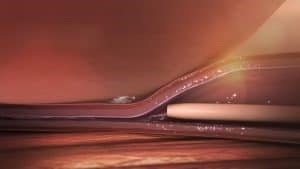- Non-Invasive Vein Treatments
If lifestyle changes and compression garments aren’t enough to eliminate the symptoms of your varicose veins, there are currently a number of Non-Invasive Vein Treatments or medical procedures that can help.
Sclerotherapy
is a common non-surgical procedure that removes smaller varicose veins and spider veins in the lower extremities. Your doctor will inject a small amount of liquid into your varicose vein. The chemical will shrink the painful and unsightly veins. To find out if you are a good candidate for sclerotherapy, schedule an appointment with your healthcare provider to discuss the procedure.
Endovenous thermal ablation
or EVTA utilizes a wire-thin catheter that delivers radiofrequency or laser energy to the varicose veins. The heat produced, causes the veins to close themselves off from the inside. The EVTA technique is minimally invasive and considered to be most effective on medium to small sized veins. The veins that have collapsed are subsequently reabsorbed via the body’s natural metabolic process. This procedure requires very little down-time and can be performed in the office.
Ambulatory phlebectomy
or AP utilizes pinpointed punctures or tiny incisions to extract unsightly and painful varicose veins. The procedure attacks each small section, one at a time. The entry sites are so small that no stitches are needed. Recovery time is also very short. Some possible complications are:
-
- Short-lived swelling and/or bruising.
- Cases of slight inflammation due to small pieces of the vein that persist in the skin.
- Numbness in the skin brought on by injury to adjoining sensory nerves.
- Allergic reaction to local anesthesia.
Vein Ligation & Stripping
are some of the early methods used to treat varicose veins. In the ligation procedure, a small incision is made over the trouble area. The vein is tied off, stopping the blood flow. Lack of blood, causes the vein to shrink and become less conspicuous. Vein stripping entails withdrawing long portions of your varicose veins via a series of incisions in your ankle and groin. This invasive procedure has now almost completely been replaced by Vein Glue.
Compression Stockings
Compression stockings also called as compression garments are special clothes made to apply pressure on the surgically treated areas most of the time.
However, they can be used to treat spider veins and small varicose veins, by applying pressure they can reduce your swelling and help you get rid of venous problems.
After diagnosing your problem, your doctor may recommend you to use compression stockings depending on your condition.
But they may recommend you to use it after your Sclerotherapy treatment too. You should wear these stockings until you don’t see any changes, or until your doctor doesn’t allow to take them off.
Does Home Treatment For Varicose Veins Work?
If your condition is modest, there are a variety of at-home treatments that can assist you in curing these vein issues, we have mentioned some of them bellow. However, if these doesn’t work then make sure to look for a doctor soon:
Exercises
We all already know how vital exercise is to our overall health. Regular exercise might also aid in the treatment of varicose veins. Yes! Some workouts, particularly the low-impact ones like walking, cycling, and yoga, are crucial at-home treatments for varicose veins. Regular exercise promotes improved blood circulation in the legs, which aids in moving blood that has accumulated in veins.
Exercise also aids in decreasing blood pressure, which is another element that contributes to the development of varicose veins. Exercises with little impact help to activate your calf muscles without adding additional stress. Try these exercises to avoid developing varicose veins.
Witch Hazelnut
Witch hazel is a herb that is very good in treating varicose veins. It is excellent for boosting blood vessel strength and easing various varicose veins symptoms. It is more than simply an astringent; it also includes essential oils and gallic acid, which serve to lessen the pain and swelling brought on by the condition of varicose veins.
To use this as a treatment for varicose veins, soak a cloth in witch hazel and apply it to the skin over the affected areas. You could achieve your desired outcomes by doing this a couple of times every day for around two months.
Another option is to bathe the affected legs in a bathtub filled with lukewarm water and 20 drops of distilled witch hazel for about 15 minutes, then rinse them off and pat them dry. You could get rid of varicose veins by doing this for two months.
What Happens If Venous Problems Are Ignored?
You shouldn’t ignore venous problems at all especially if it’s varicose veins since they are more serious than spider veins. There are some complications you may face if you ignore vein problems.
- Blood Clots
Blood clots are normal vein problems, this happens when your blood vessels are damaged, this can also can vein problems.
Not treating varicose veins can increase the number of varicose veins and make your situation worse, therefore don’t delay the treatment.
The more you delay the treatment, the worse your situation will be.
- Increased Pain And Swellings
When you ignore a problem like spider veins or varicose veins you make yourself suffer from pain and swelling for a really long time.
Since your problem won’t be treated you will keep experiencing pain.
- Vein Rupture
The scariest thing that can happen to your veins is vein rupture, a condition where your vein will burst because of too much pressure and swellings.
If this happens it’s important to get the right treatment as soon as possible or you may loose a lot of blood, which can lead to many other problems and cause you blackouts.
How To Prevent Varicose Veins In Future?
Raise Your Legs
The blood will start to flow back towards your heart if you raise your legs 15 minutes above your heart three times a day.
Wear Compression Socks or Hose Compression socks and stockings prevent blood from pooling, swelling, and pain while maintaining the proper operation of your vein valves.
Include physical activity in your daily routine
The best form of exercise to avoid varicose veins is walking. Yoga positions that raise your feet above your heart are excellent for preventing varicose veins.
Is there any downtime or recovery period after non-invasive vein treatments?
Non-invasive vein treatments typically involve minimal to no downtime, allowing individuals to resume normal activities shortly after the procedure. However, experiences can vary based on the specific type of treatment and the individual’s response.
Commonly, patients are encouraged to avoid strenuous activities, such as heavy lifting or intense exercise, for a short period after the procedure. Wearing compression stockings as recommended by the healthcare provider may also be advised to optimize results and minimize potential side effects.
It’s crucial to follow post-treatment care instructions provided by the healthcare professional to ensure a smooth recovery and achieve the best outcomes.
How soon can one expect to see results after undergoing non-invasive vein treatments?
The timeframe for seeing results after non-invasive vein treatments can vary depending on the specific procedure and individual factors. However, some individuals may notice improvement shortly after the treatment, while others may take a few weeks to see full results.
For procedures like laser therapy or sclerotherapy, changes in the appearance of veins may become noticeable within a few weeks as the body gradually absorbs and processes the treated veins.
It’s essential to have realistic expectations and follow any post-treatment care instructions provided by your healthcare professional. Additionally, it’s common for multiple sessions to be recommended for optimal results, and improvements may continue to develop over time.
Always consult with your healthcare provider for accurate information about the expected timeline for results based on the type of non-invasive vein treatment you undergo.
Can non-invasive treatments address both cosmetic and medical concerns related to veins?
Yes, non-invasive vein treatments can address both cosmetic and medical concerns related to veins. These treatments are designed to improve the appearance of veins, such as spider veins or varicose veins, while also addressing underlying medical issues associated with venous insufficiency.
Is there any downtime associated with non-invasive vein treatments?
Non-invasive vein treatments typically involve minimal to no downtime. Patients can usually resume their normal activities immediately after the procedure. However, it’s essential to follow post-treatment care instructions provided by the healthcare professional to optimize results and minimize potential side effects. While most people can return to work or daily routines promptly, it’s advisable to avoid strenuous activities or excessive sun exposure for a short period as recommended by the healthcare provider.
Is there a specific age range for individuals seeking non-invasive vein treatments?
There isn’t a specific age range for individuals seeking non-invasive vein treatments. The decision to pursue such treatments is based on the presence of vein-related concerns rather than age. People of various ages may seek non-invasive options for cosmetic or medical reasons, such as addressing varicose or spider veins. The suitability for treatment is determined on a case-by-case basis, considering factors like overall health and the specific vein condition.
Are there cases where surgery Is more suitable than non-invasive treatments for veins?
Yes, there are cases where surgery may be more suitable than non-invasive treatments for veins. In some instances, the severity or specific characteristics of the vein condition may require a more invasive approach. Surgical options might be considered when non-invasive treatments have proven ineffective or when dealing with complex or larger veins. Additionally, certain medical conditions or anatomical factors could influence the choice between surgery and non-invasive procedures.
What are the potential risks or side effects of non-invasive vein treatments?
Non-invasive vein treatments, such as sclerotherapy or laser therapy, typically have minimal risks. Common side effects may include temporary redness, swelling, or bruising at the treated site. In rare instances, patients may experience changes in skin pigmentation or develop allergic reactions to treatment agents. Serious complications are uncommon but could include blood clot formation or infection.


